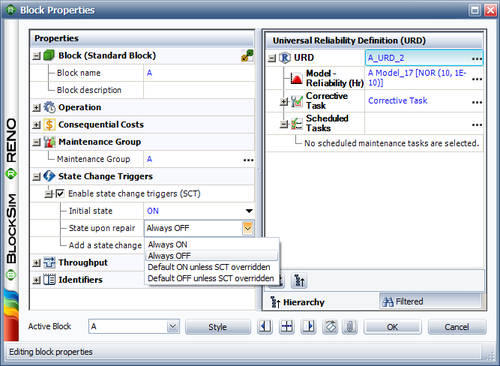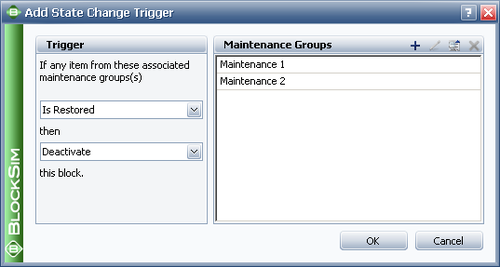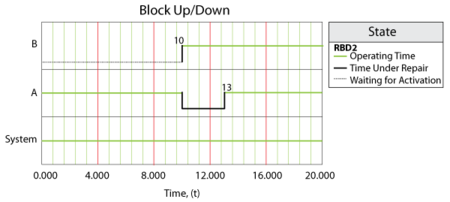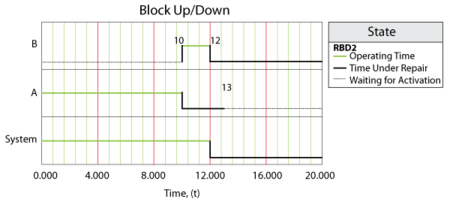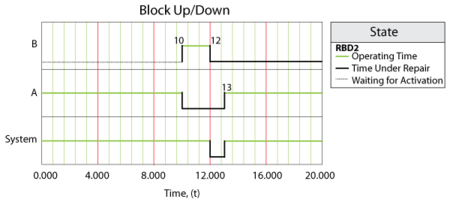State Change Triggers: Difference between revisions
Lisa Hacker (talk | contribs) (→Case 3) |
Lisa Hacker (talk | contribs) (→Case 3) |
||
| Line 59: | Line 59: | ||
The option "Default ON unless SCT overridden" is similar to "Default OFF unless SCT overridden"; it means that the default state upon repair for a block is ON. However, it can be overridden by a trigger to change the state upon repair to "OFF." | The option "Default ON unless SCT overridden" is similar to "Default OFF unless SCT overridden"; it means that the default state upon repair for a block is ON. However, it can be overridden by a trigger to change the state upon repair to "OFF." | ||
< | <center><div style="width: 90%; background-color:#EEEEEE; padding: 10px; border:thin; border-color: #DDDDDD;"><hr><p style="font-family: Arial; font-size: 12pt; font-weight: bold; color:#336699; margin-bottom: 0px;">See it in action...</p><p>More application examples are available! See also:</p> <ul><li>[[Example_Using_SCT_for_Standby_Rotation|Using SCT for Standby Rotation]]</li><li>[[Example_Using_SCT_to_Analyze_Tire_Maintenance|Using SCT to Analyze Tire Maintenance]]</li><li>[[Example_Using_SCT_to_Analyze_Standby_with_Delay|Using SCT to Analyze Standby with Delay]]</li><li>[[Example_Using_SCT_to_Model_Two_Standby_Blocks|Using SCT to Model Two Standby Blocks]]</li><li>[[BlockSim_Example:_Default_OFF_unless_SCT_Overridden|Default OFF Unless SCT Overridden]]</li><li>[[BlockSim_Example:_Default_ON_unless_SCT_Overridden|Default ON Unless SCT Overridden]]</ul><hr></div></center> | ||
<div style="width: 90%; background-color:#EEEEEE; padding: 10px; border:thin; border-color: #DDDDDD;"><hr><p style="font-family: Arial; font-size: 12pt; font-weight: bold; color:#336699; margin-bottom: 0px;">See it in action...</p><p>More application examples are available! See also:</p> <ul><li>[[Example_Using_SCT_for_Standby_Rotation|Using SCT for Standby Rotation]]</li><li>[[Example_Using_SCT_to_Analyze_Tire_Maintenance|Using SCT to Analyze Tire Maintenance]]</li><li>[[Example_Using_SCT_to_Analyze_Standby_with_Delay|Using SCT to Analyze Standby with Delay]]</li><li>[[Example_Using_SCT_to_Model_Two_Standby_Blocks|Using SCT to Model Two Standby Blocks]]</li><li>[[BlockSim_Example:_Default_OFF_unless_SCT_Overridden|Default OFF Unless SCT Overridden]]</li><li>[[BlockSim_Example:_Default_ON_unless_SCT_Overridden|Default ON Unless SCT Overridden]]</ul><hr></div> | |||
<p style="clear: both;"> </p> | <p style="clear: both;"> </p> | ||
Revision as of 01:48, 8 August 2012
 |
This article, which discusses the use of State Change Triggers (SCT) in simulation diagrams, also appears in the System Analysis Reference book.
Consider a case where you have two generators, and one (A) is primary while the other (B) is standby. If A fails, you will turn B on. When A is repaired, it then becomes the standby. State change triggers (SCT) allow you to simulate this case. You can specify events that will activate and/or deactivate the block during simulation. The figure below shows the options for state change triggers in the Block Properties window.
Once you have enabled state change triggers for a block, there are several options.
- Initial state allows you to specify the initial state for the block, either ON or OFF.
- State upon repair allows you to specify the state of the block after its repair. There are four choices: Always ON, Always OFF, Default ON unless SCT Overridden and Default OFF unless SCT Overridden. In the Assumptions sections, we will explain what these choices mean and illustrate them using an example.
- Add a state change trigger allows you to add a state change trigger to the block.
The state change trigger can either activate or deactivate the block when items in specified maintenance groups go down or are restored. To define the state change trigger, specify the triggering event (i.e., an item goes down or an item is restored), the state change (i.e., the block is activated or deactivated) and the maintenance group(s) in which the triggering event must happen in order to trigger the state change. Note that the current block does not need to be part of the specified maintenance group(s) to use this functionality.
The State Change Trigger window is shown in the figure below:
Assumptions
- A block cannot trigger events on itself. For example, if Block 1 is the only block that belongs to MG 1 and Block 1 is set to be turned ON or OFF based on MG 1, this trigger is ignored.
- OFF events cannot trigger other events. This means that things cannot be turned OFF in cascade. For example, if Block 1 going down turns OFF Block 2 and Block 2 going down turns OFF Block 3, a failure by Block 1 will not turn OFF Block 3. Block 3 would have to be directly associated with downing events of Block 1 for this to happen. The reason for this restriction is that allowing OFF events to trigger other events can cause circular reference problems. For example, four blocks A, B, C and D are in parallel. Block A belongs to MG A and initially it is ON. Block B belongs to MG B and its initial status is also ON. Block C belongs to MG C and its initial status is OFF. Block D belongs to MG D and its initial status is ON. A failure of Block A will turn OFF Block B. Then Block B will turn Block C ON and finally C will turn OFF Block D. However, if an OFF event for Block D will turn Block B ON, and an ON event for Block B will turn Block C OFF, and an OFF event for Block C will turn Block D ON, then there is a circular reference problem.
- Upon restoration states:
- Always ON: Upon restoration, the block will always be on.
- Always OFF: Upon restoration, the block will always be off.
- Default ON unless SCT overridden: Upon restoration, the block will be on unless a request is made to turn this block off while the block is down and the request is still applicable at the time of restoration. For example, assume Block A's state upon repair is ON unless SCT overridden. If a failure of Block B triggers a request to turn Block A off but Block A is down, when the maintenance for Block A is completed, Block A will be turned off if Block B is still down.
- Default off unless SCT overridden: Upon restoration, the block will be off unless a request is made to turn this block on while the block is down and the request is still applicable at the time of restoration
- Maintenance while block is off: Maintenance tasks will be performed. At the end of the maintenance, "upon restoration" rules will be checked to determine the state of the block.
- Assumptions for phases: The state of a block (on/off) will be determined at the beginning of each phase based on the "Initial state" setting of the block for that phase.
- If there are multiple triggering requests put on a block when it is down, only the latest one is considered. The latest request will cancel all requests before it. For example, Block A fails at 20 and is down until 70. Block B fails at 30 and Block C fails at 40. Block A has state change triggers enabled such that it will be activated when Block B fails and it will be deactivated when Block C fails. Thus from 20 to 70, at 30, Block B will put a request on Block A to turn it ON and at 40, Block C will put another request to turn it OFF. In this case, according to our assumption, the request from Block C at 40 will cancel the request from Block B at 30. In the end, only the request from Block C will be considered. Thus, Block A will be turned OFF at 70 when it is done with repair.
Example: State Upon Repair
Consider an example in which there are two generators. A is the primary generator and B is a standby. If A fails, B is turned ON. Further assume that A fails every 10 hours and gets repaired in 3 hours. B fails every 20 hours and cannot be repaired. State change triggers can be used to model this example.
Case 1
- Block A belongs to Maintenance Group A. In "Enable state change triggers(SCT)," "Initial State" is ON and "State upon repair" is "Always ON." A state change trigger is added to Block A: If B goes down, then activate this block.
- Block B belongs to Maintenance Group B. In "Enable state change triggers(SCT)," "Initial State" is OFF and "State upon repair" is "Always ON." A state change trigger is added to Block B: If A goes down, then activate this block.
We run one simulation with an end time of 20 hours. The system event log plot is shown in the figure below.
From the figure, we can see that Block A fails at 10 hours and Block B is activated at the same time. At 13 hours, Block A is restored and according to the "State upon repair" setting, it is ON. In this case, from 13 hours to 20 hours, both generators are running. Perhaps we feel that it is not economical to run both generators at the same time; if one is running, we should set the other one as standby. Thus after Block A is repaired, we would prefer for it to stay as a standby. This leads to Case 2 next.
Case 2
Everything is the same as in Case 1 except for two changes, as follows:
- The "State upon repair" for the state change trigger on Block A is changed from "Always ON" to "Always OFF."
- Block B fails every 2 hours and never get repaired.
We run one simulation with an end time of 20 hours. The system event log plot is shown in the figure below.
From the plot above, we can see that, as we expected, Block A will become a standby after its repair at 13 hours. However, another problem arises. In Case 1, Block B fails every 20 hours. In this case, it fails every 2 hours. Thus, before A is repaired, Block B fails at 12 hours. However, Block A is down at 12 hours, thus cannot be activated by failure of Block B. Due to this, the failure of Block B brings the system down all the way to the end of the simulation. This is not desirable. In Case 3, we address this.
Case 3
Everything is the same as in Case 2 except for the following change:
- The "State upon repair" for the state change trigger on Block A is changed to "Default OFF unless SCT overridden".
We run one simulation with an end time of 20 hours. The system event log plot is shown in the figure below.
From the plot above, we can see that at 12 hours, when Block B fails, it tries to activate Block A. However, at this time, Block A is down for repair. At 13 hours, the repair on Block A is finished and, according to the "State upon repair" setting, the block's state upon repair is overridden by the trigger sent by Block B at 12 hours. Thus Block A is ON after its repair. This is the kind of scenario we expected.
The option "Default ON unless SCT overridden" is similar to "Default OFF unless SCT overridden"; it means that the default state upon repair for a block is ON. However, it can be overridden by a trigger to change the state upon repair to "OFF."
See it in action...
More application examples are available! See also:
- Using SCT for Standby Rotation
- Using SCT to Analyze Tire Maintenance
- Using SCT to Analyze Standby with Delay
- Using SCT to Model Two Standby Blocks
- Default OFF Unless SCT Overridden
- Default ON Unless SCT Overridden
